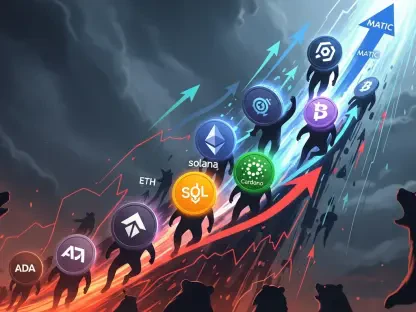Kofi Ndaikate is well-versed in the dynamic world of Fintech. His expertise spans various industry areas, from blockchain and cryptocurrency to regulation and policy. Today, we discuss key insights from Signicat’s “The Battle Against AI-Driven Identity Fraud” report, focusing on the dramatic increase in deepfake fraud, its types, and how financial institutions can better protect themselves against these threats.
Can you provide an overview of the main findings from Signicat’s “The Battle Against AI-Driven Identity Fraud” report?
The report highlights a dramatic increase in deepfake fraud incidents, which have surged by 2137% over the past three years. It reveals that AI-driven identity fraud, particularly through deepfake technology, is becoming a significant threat in the financial sector. The findings stress the need for enhanced fraud prevention strategies to counter this growing risk.
What factors have contributed to the 2137% increase in deepfake fraud over the last three years?
Several factors have contributed to this surge, including advancements in AI technology, which make creating and deploying deepfakes easier and more convincing. Additionally, the increased digitization of financial services has provided more targets and opportunities for fraudsters to exploit these technologies.
How does the report distinguish between presentation attacks and injection attacks in the context of deepfake fraud?
Presentation attacks involve fraudsters using physical masks, makeup, or screens displaying deepfakes in real-time to impersonate someone else. These are typically used in account takeovers or fraudulent loan applications. Injection attacks, on the other hand, involve the insertion of malicious or untrusted input—such as pre-recorded videos—into a system, often during onboarding or KYC processes, compromising its integrity.
Could you give examples of how presentation attacks typically occur in financial fraud?
Presentation attacks often occur when a fraudster uses a deepfake video to appear as someone else during a video verification process. For instance, they might play a deepfake video of a legitimate customer during a bank’s account setup procedure, tricking the system into verifying their fake identity.
How do injection attacks differ in execution from presentation attacks, particularly during onboarding or KYC processes?
Injection attacks differ in that they involve inserting pre-recorded deepfake videos directly into the verification process, bypassing live interaction. This can be done by hacking into the system and inserting these videos during critical stages like onboarding or KYC checks to deceive the system into accepting the fake identity.
According to the report, what percentage of fraud attempts in the financial sector are now due to AI-driven techniques?
The report indicates that AI-driven techniques account for 42.5% of fraud attempts detected in the financial sector. This underscores the growing sophistication and prevalence of these methods.
How has the prevalence of deepfake fraud in digital identity fraud changed over the past three years?
Deepfake fraud has seen a significant increase, rising from 0.1% to 6.5% of all fraud attempts. This 2137% increase highlights how quickly deepfake technology has become a major tool for identity fraud.
What challenges do traditional fraud detection systems face in identifying and preventing deepfake attacks?
Traditional fraud detection systems often struggle with the sophistication of AI-driven techniques. Deepfakes can be incredibly convincing, making it difficult for older systems to differentiate between genuine and fake identities, leading to higher instances of successful fraud.
Why have only 22% of financial institutions implemented AI-based fraud prevention tools despite the rise in AI-driven fraud attempts?
Implementing AI-based tools can be resource-intensive and costly, leading to resistance from some institutions. Additionally, there may be a lack of awareness or urgency to update existing systems until a breach or significant loss occurs.
What recommendations does Signicat’s report make for organizations to enhance their fraud prevention strategies?
The report recommends adopting advanced detection systems that combine AI, biometrics, and robust identity verification processes. It stresses the importance of early risk assessment, biometric-based authentication, and ongoing monitoring to effectively combat these sophisticated threats.
How important is a multi-layered approach in combating deepfake and other AI-driven fraud attempts?
A multi-layered approach is crucial as it combines various tools and methods to provide a comprehensive defense. This includes early risk assessment, robust identity checks, real-time monitoring, and AI-driven analytics to better detect and prevent fraud.
Can you explain the role of AI, biometrics, and identity verification in a robust fraud detection system?
AI can analyze data patterns to detect anomalies, biometrics provide unique identifiers that are difficult to fake, and thorough identity verification ensures that individuals are who they claim to be. Together, these elements form a robust deterrent against fraudulent activities.
How does early risk assessment contribute to fraud prevention in the financial sector?
Early risk assessment identifies potential threats before they can cause harm. By analyzing behavioral patterns and transaction data, financial institutions can flag suspicious activities early, preventing fraud attempts from succeeding.
Why is ongoing monitoring crucial for protecting both company operations and customers?
Ongoing monitoring ensures continuous vigilance against new and evolving threats. It helps detect anomalies in real-time, allowing institutions to respond swiftly to prevent breaches and protect sensitive data and assets.
In your opinion, what specific steps should financial institutions take to strengthen their cybersecurity measures against deepfake fraud?
Financial institutions should invest in advanced AI-based detection tools, incorporate biometric verification methods, educate employees and customers about deepfake threats, and regularly update their security protocols to keep pace with evolving technologies.
How can businesses improve employee and customer awareness to better deal with evolving threats like deepfake fraud?
Regular training sessions, awareness campaigns, and updates on current threats can keep employees and customers informed. Simulated phishing exercises and educational materials can also help them recognize potential fraud attempts.
What is the significance of “orchestration” in the context of multi-layered protection against fraud?
Orchestration involves integrating various security tools and protocols in an optimal configuration to create a seamless and robust defense system. It ensures that all layers of protection work together harmoniously to detect and prevent fraud effectively.
Can you discuss how cybercriminals are leveraging advanced technologies to exploit financial systems?
Cybercriminals use AI to create deepfakes and other sophisticated attacks that can bypass traditional security measures. They exploit vulnerabilities in financial systems and use advanced technologies like machine learning and blockchain to enhance the efficiency and effectiveness of their fraudulent activities.
From a strategic perspective, how can organizations stay ahead of rapidly evolving threats in the digital fraud landscape?
Organizations must adopt a proactive approach by investing in the latest fraud detection technologies, continually updating their security measures, and staying informed about emerging threats. Collaboration with industry peers and participation in security forums can also help them stay ahead.
What actions can financial institutions and businesses take immediately to mitigate the risks posed by deepfake fraud?
Immediate actions include implementing AI-based detection tools, enhancing identity verification processes with biometrics, conducting comprehensive risk assessments, and educating both employees and customers on recognizing and responding to deepfake fraud attempts.
Do you have any advice for our readers? S
tay informed about the latest developments in AI and cybersecurity, and take proactive steps to protect your personal and financial information. Regularly update your passwords, use multi-factor authentication, and remain vigilant against suspicious activities. Awareness and preparedness are your best defenses against these evolving threats.









